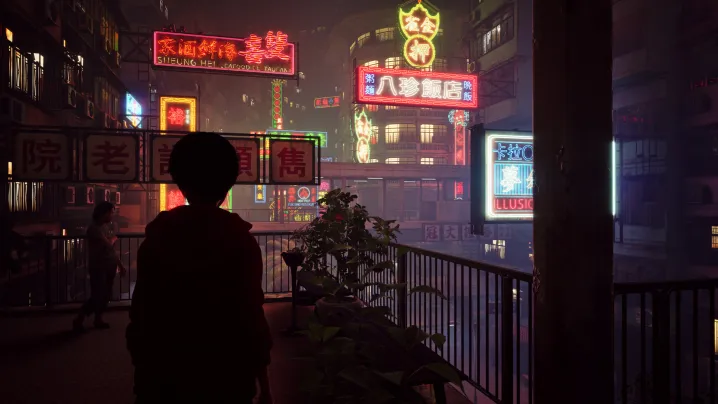
“Slitterhead is the most creative action game that I've played this year, but it's also deeply flawed.”
- Extremely creative
- Thought-provoking narrative
- Body-hopping mechanic is novel
- Lack of voice acting in key scenes
- Underbaked combat
- Extremely repetitive
When a lauded creator goes independent to create their own project, the results are always fascinating. More importantly, they’re typically quite weird. We’ve previously seen this with games like Death Stranding, but Slitterhead is the latest entry into that eccentric pantheon.
Slitterhead is a new action horror game from Keiichiro Toyama, the director behind classics like the first Silent Hill, Siren, and Gravity Rush. What Toyama’s team at Bokeh Game Studio has created is unlike anything else I’ve played before. Slitterhead is imperfect, as its action gameplay doesn’t wholly hit the mark, and Bokeh’s ambition seemed to be a little bigger than what it could achieve as an independent studio working on its first game.
I don’t regret playing Slitterhead, though, as it’s the kind of funky, creative experience you only get from creators who are not worried about holding anything back now that they’re on their own.
The cycle of violence
In Slitterhead, players control a spirit sent back in time and trapped in an eternal battle with bug-like creatures called Slitterheads that eat people’s brains and then possess them as mimics. The character designs of these Slitterheads are all outstanding, as is Akira Yamaoka’s soundtrack. With Siren, Toyama showed adeptness at creating a nonlinear narrative, and Slitterhead is quite similar in that manner, as all of its missions are set across the span of three days.
It’s shooting for the stars, but can’t quite get there.
Slitterhead’s narrative is nonlinear in terms of when events take place on the game’s timelines, and its levels often loop back in on themselves. That can get repetitive, but this approach leads to some unexpected twists as players learn more about the spirit (eventually named Night Owl), the Slitterhead threat, and the “Rarity” humans with special powers that Night Owl possesses. Like The Last of Us Part 2, Slitterhead is ultimately a story about cycles of violence and how innocents can be caught in the crossfire of those struggles.
Night Owl has no problem jumping body to body for its personal gain. After letting players wallow in those mechanics for some time, Slitterhead eventually takes a step back and critiques that in a thought-provoking way. By the end of the adventure, I truly came to care for some of the Rarity humans as Night Owl did, and I found myself jumping to the bodies of random civilians less.
Slitterhead’s narrative is ultimately held back by its production value. The game is not fully voiced, but presents its dialogue like it is. While this is likely a budget constraint for an independent studio, focusing on written dialogue at the bottom of the screen in the middle of a fight could be tough. Some moments could have had more emotional impact if they were fully voiced and not just backed by a grunt audio clip. That’s emblematic of Slitterhead at large: it’s shooting for the stars, but can’t quite get there.
Body-hopping horror action
Slitterhead is not a survival horror game like Silent Hill or Siren. This is a full-on action game with elements of body horror as players track down and kill the titular monsters. Sometimes, these creatures will take the initiative and attack players; at other times, they will run away when spotted. I enjoyed chasing down Slitterheads, intensely hopping from body to body to keep up with them as they jumped across rooftops, down to street level, and tried to get out of sight. If they did, I then had to sightjack their perspective, Siren-style, and discern where they were in the environment to kick off the chase again.
It’s a feeling I’ve only gotten from superhero games with chases like Batman: Arkham Knight or Marvel’s Spider-Man, and the one standout aspect of Slitterhead’s gameplay. Eventually, the enemies I chased did get backed into a corner and transformed into massive, bug-like creatures for me to take down. In these moments, Slitterhead’s approach to combat does not always pay off.

There’s not much combat depth in the way of combos because the idea in Slitterhead is that players will be hopping from body to body to attack the creatures from different angles. Each human the Night Owl possesses creates a “blood weapon” to fight with and can use special abilities at the cost of their health. Rarities have even more powerful abilities and passive buffs, making them much more effective than a random human off the street.
This body-hopping combat certainly isn’t like anything I’ve played, but its novelty wears thin as fighting doesn’t feel very good. Slitterhead lacks a precise lock-on system, only focusing on an enemy when players hold down the left trigger to defend or queue up a special ability. It’s possible to deflect enemy attacks, but that’s never really necessary on normal difficulty, and the timing of when the deflect indicator appears is off. Fights can also be cheesed with certain Rarity abilities on normal difficulty. The action not feeling great in a horror action game is certainly a big red flag.
Repetitive to a fault
Slitterhead’s gameplay ultimately does succumb to its repetitiveness. Although the story is intriguing, its chases are exhilarating, and body-hopping during combat is novel, the latter two things don’t evolve throughout the game as the story does. Yes, I got access to new Rarities with different abilities, but the tactics of the Slitterheads I was fighting didn’t change much.
Over time, I also discovered certain Rarities were better than others, so I startted picking unique duos to bring into each level with me. Then, those levels were just strings of the same kinds of Slitterhead fights repeatedly, only occasionally breaking form for a unique set piece or cinematic. Considering that the combat itself already wasn’t quite that polished, I started to have less and less fun as Slitterhead dragged on.

Despite those qualms, I appreciate Slitterhead’s boldness and the fact that it’s not quite like anything I’ve played before. That sense of novelty motivated me to see where the adventure goes next. I’m curious to see others’ analyses of Slitterhead’s story, and I hope the ideas that this game introduces with its nonlinear structure and body-hopping gameplay are expounded upon in future games.
Slitterhead might not execute its vision in a polished or refined manner, but I commend Bokeh’s efforts. We need this industry’s brightest minds to keep experimenting with new ideas and attempting to push gaming forward. Those efforts can sometimes be extremely flawed, as they are here, but they also drive as an artistic medium to new heights. Toyama’s latest doesn’t live up to the high bar of Silent Hill or Siren, but it’s just as creatively inspired as those classics. That’s why I’m still happy that this game got made — even if it’s not very good.
Slitterhead was tested on Xbox Series X with a code provided by the publisher.



